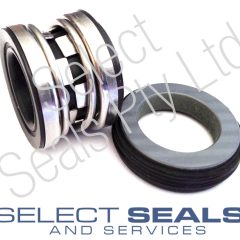Compensating for Oxygen Concentration

Flange severely damaged by ignition in oxygen. Photo: FSA
THE AIR we breathe contains by volume 78 percent nitrogen, 21 percent oxygen and approximately 1 percent argon.
Oxygen concentrations as high as 23 percent are considered acceptable by OSHA. However, in many areas of industry and medicine where technical or high-purity oxygen is used, oxygen concentrations can exceed 23 percent and create what is known as “flammable atmosphere,” leading to serious accidents (see Image 1.) and the inability for workers to self-rescue from hazardous situations when proper care is not taken.
Oxygen is non-flammable, but it is a fire promoter and can accelerate combustion and thus is a hazardous substance. Ignition may be caused by sparking, welding or using electric tools when concentrations rise above 23 percent. Materials of construction, education and testing go far to prevent these hazards in industrial settings.
Material Selection
In the industrial market, it is important for safety that the proper construction materials, both metallic and non-metallic, are used for equipment. Contaminants such as oils, fats or organic particles can create unsafe conditions in operation and must be avoided (see Image 2). Additionally, stable processes are needed to avoid pressure surges or very high flow velocities.
Packing ring under UV light showing particulate contamination
Where a high concentration of oxygen is present, unstable processes can lead to life threatening burn-outs of valves and other components. Tests in accordance with existing technical standards regarding the suitability for oxygen applications are required for non-metallic materials used in oxygen valves, components or pipe lines. This includes sealing materials such as gland packings and gaskets in addition to the valve assembly and hoses.
When considering any material for use in oxygen service, the application, operating parameters and working duty pattern of use must be taken into account.
These include minimum and maximum operating conditions (flow rate, temperature, pressure and process-upset conditions) that can be encountered in service. Where appropriate, the tests can also take into account the use in liquid oxygen (LOX) service.
Such tests are carried out, for example, by the Bundesanstalt Fur Materialforschung und-prufung (BAM) in Germany, or commercial laboratories such as Wendell Hill & Associates in the U.S. The results summarized in the reports contain information about the maximum operating pressure and temperature for safe use in compressed oxygen gas in addition to information on use in liquid oxygen. The results relate exclusively to the specific batch of the specific sample material. Such test reports are not an approval, and no certificate or license is issued. Instead, they provide information for consideration by plant operators, engineers and original equipment manufacturers (OEMs).
Valve manufacturers are recommended to test their complete valves or components at institutes such as those mentioned above. Only then can the whole system be assessed in terms of safety for the intended oxygen application.
Information Is Key
End users must ensure that the gasket manufacturers and packing braiders are explicitly informed about the intended oxygen application during the order process and that the gland packings and gaskets are handled as carefully as possible in the production process of the manufacturers.
It is also their responsibility to check whether the safety assessment meets the requirements of the end user or operator. Usually gland packings and gaskets for oxygen use are separately manufactured (free from oil, grease and other sources of contamination), checked and individually packaged following special precautions. This information must be indicated on the packaging as an imprint, or on the label.
In order to ensure the safety and availability of oxygen service valves and components, a continuous chain must be created. Starting from the production of the materials through their further processing into components and safety assessments, the chain ends with usage in the plant.
The production processes and test procedures currently differ significantly from manufacturer to manufacturer, as does the handling of these issues by the end users. In fact, there are no standards or rules that regulate this process except for the national and international standards specifying the test procedures for the safety assessment of the materials, valves and components.
To address this less-than-desirable lack of regulations, working groups with participants from packing and gasket manufacturers have already been formed and include end-user participants. In the field of safety and environmental protection a significantly increased awareness needs to be created of the danger of industrial oxygen applications. This includes careful selection of gland packings and gaskets to ensure the implementation of the best available techniques.



